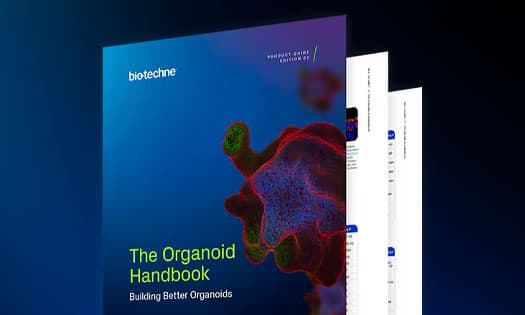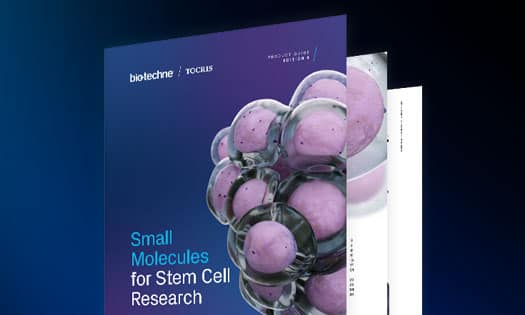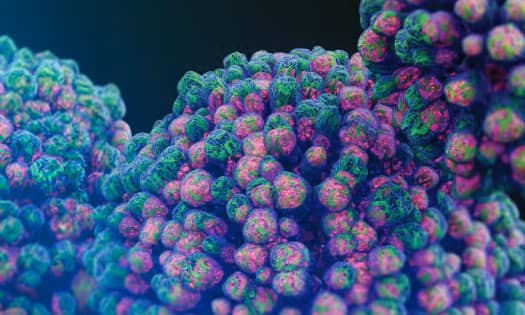Benefits of Using Small Molecules
Small molecules have several qualities that make them useful tools in the growth and maintenance of organoids:
|
|
|
|
|
|
Small Molecule Product Tables
Relevant Organoid Systems
| Neuronal- N Gastrointestinal- G.I. Liver- Li | Lung- L Prostate- Pr Kidney- K | Retinal- R Inner Ear- I.E. Cardiac- C | Pancreatic- P Stomach- S | Glial- G Urothelial- U.T. |
| Product | Catalog # | Relevant Organoid Systems | Functions |
| A 83-01* | 2939 | N, G.I., L, P, I.E., Pr | Selective inhibitor of TGF-βRI, ALK4/ALK7 |
| AGN 193109* | 5758 | R, K | High affinity pan-RAR antagonist |
| AM 580* | 0760 | K | RARα agonist |
| BDNF (human) | 2837 | N | Activated TrkB and p75 neurotrophin receptors |
| CHIR 99021** | 4423 | N, K, P, G.I., L, I.E., C, Li | Selective GSK-3 inhibitor, Wnt activator |
| CHIR 99021 in solution | 8170 | N, K, P, G.I., L, I.E., C, Li | Ready-to-use 10mM solution of CHIR 99021 pre-dissolved in DMSO |
| Compound E | 6476 | N, P | γ-secretase and Notch pathway inhibitor |
| DAPT* | 2634 | N, R, Li | γ-secretase inhibitor |
| DBZ* | 4489 | N, G.I. | γ-secretase aspartyl protease inhibitor |
| Dexamethasone* | 1126 | Li | Anti-inflammatory glucocorticoid |
| Dorsomorphin | 3093 | K, N, G | AMPK and BMP type 1 receptor inhibitor |
| endo-IWR 1* | 3532 | N | Wnt/β-catenin signaling inhibitor |
| Erlotinib Hydrochloride | 7194 | U.T. | EGFR tyrosine kinase inhibitor |
| Forskolin* | 1099 | N, Li, P | Adenylyl cyclase activator |
| Galunisertib | 6956 | U.T. | ALK4/ALK5 (TGFβRI) inhibitor |
| Gastrin I (human) | 3006 | S, Li | Selective CCK2 agonist |
| Heparin sodium salt | 2812 | K, G | Anticoagulant |
| Iressa | 3000 | L | Selective EGFR inhibitor |
| ISX 9* | 4439 | N, G.I., P | Neurogenic agent |
| IWP 2 | 3533 | C | Wnt pathway & PORCN inhibitor |
| IWP 4 | 5214 | C | Wnt/β-catenin signaling inhibitor |
| L-Ascorbic acid* | 4055 | N, P, Li | Cav3.2 channels inhibitor |
| LDN 193189** | 6053 | N, G, K, P | Selective ALK2/ALK3, Smad1/5/8 inhibitor |
| LDN 193189 in solution | 8150 | N, G, K, P | Ready-to-use 10mM solution of LDN 193189 pre-dissolved in water |
| Nicotinamide* | 4106 | Li, P, G.I. | PARP-1 inhibitor |
| PD 0325901 | 4192 | I.E. | MEK1/2 inhibitor |
| PD 0332991 | 4786 | N, U.T. | Cdk4/6 inhibitor |
| Prostaglandin E2 | 2296 | Pr, Li | Promotes hematopoietic stem cell expansion |
| RepSox* | 3742 | P | TGF-βRI inhibitor |
| Retinoic Acid* | 0695 | N, K, G, R | Retinoic acid receptor agonist |
| Rosiglitazone | 5325 | U.T. | Selective PPARγ agonist |
| SANT-1 | 1974 | P | Hedgehog pathway inhibitor |
| SB 202190 | 1264 | G.I., Pr | Selective p38 MAPK inhibitor |
| SB 431542** | 1614 | N, G, L, I.E., Li, P | Selective TGF-βRI, ALK4/ALK7 inhibitor |
| Staurosporine* | 1285 | N, R | Non-selective protein kinase inhibitor |
| T3* | 6666 | P, G, C, Li | Thyroid hormone |
| TM2 TEAD inhibitor | 7917 | Li | TEAD-mediated Hippo/Yap signaling inhibitor |
| Tocriscreen Stem Cell Library | 7340 | A library of 120 stem cell compounds to explore stem cell reprogramming, differentiation, proliferation and signaling | |
| XAV 939** | 3748 | N, L, I.E. | Tankyrase inhibitor |
| WIKI4 | 4855 | P, N, C | Tankyrase inhibitor |
| Wnt-C59 | 5148 | P, C, N | PORCN inhibitor |
*Ancillary Material Grade Small Molecules and **GMP small molecules are available
| Cell Culture Product | Catalog # | Functions |
| CEPT Cocktail Kit | 7991 | Cell culture supplement for improving stem cell survival containing Chroman 1, Emricasan, Polyamine Supplement, trans-ISRIB and DMSO |
| Chroman 1 | 7163 | Selective ROCK2 inhibitor; improves cell survival after cryogenesis |
| DMSO, Cryopreserve Grade | 7726 | Protective agent for freezing of cell cultures |
| Emricasan | 7310 | Caspase inhibitor; improves survival of differentiated cells |
| HEPES | 3173 | Multipurpose buffer for 3D cell culture |
| N-Acetylcysteine | 7874 | Commonly used in multiple stages of organoid generation; GSH precursor; antioxidant |
| Polyamine Supplement | 7739 | Enhance stem cell viability |
| Thiazovivin | 3845 | ROCK inhibitor; improves the efficiency of fibroblast reprogramming and induction of iPSCs |
| Tissue Clearing Pro Organoid | 7390 | 3D cell culture clearing reagent kit |
| trans-ISRIB | 5284 | Integrated stress response inhibitor |
| Y-27632 dihydrochloride** | 1254 | Passaging and freezing of cell cultures |
| Y-27632 in solution | 7000 | Ready-to-use 10mM solution of Y-27632 pre-dissolved in water |
Organoid Data Using Small Molecules

iPSC-derived Human Heart-forming Organoids. Human iPSCs were embedded in Cultrex UltiMatrix RGF Basement Membrane Extract (R&D Systems, Catalog # BME001-05) and differentiated with CHIR 99021 (Tocris Bioscience, Catalog # TB4423-GMP) and IWP 2 (Tocris Bioscience, Catalog # 3533) into heart-forming organoids based on a protocol from Drakhlis, L. et al. (2021) Nat. Biotechnol. 39:737. Successful differentiation was demonstrated by staining the cells with A) Rabbit Anti-Human Cardiac Troponin T Antigen Affinity-purified Polyclonal Antibody (green; Novus Biologicals, Catalog # NBP3-13391) to detect cardiomyocytes and Goat Anti-Human CD31/PECAM-1 Antigen Affinity-purified Polyclonal Antibody (red; R&D Systems, Catalog # AF3628) to detect endothelial cells. The cells were counterstained with DAPI (blue; Tocris Bioscience, Catalog # 5748). As formation of early embryonic heart anlagen is associated with nascent foregut endoderm development, cells were also stained with B) Goat Anti-Human SOX2 Antigen Affinity-purified Polyclonal Antibody (red; R&D Systems, Catalog # AF2018) and Mouse Anti-Human HNF-4 alpha/NR2A1 Monoclonal Antibody (green; R&D Systems, Catalog # PP-K9218-00) to detect anterior and posterior foregut endoderm cells, respectively. The cells were counterstained with DAPI (blue; Tocris Bioscience, Catalog # 5748).

Culture and Characterization of Adult Stem Cell-derived Human Descending Colon Organoids. Adult stem cells isolated from human descending colon were embedded in Cultrex UltiMatrix RGF Basement Membrane Extract (R&D Systems, Catalog # BME001-05) and cultured for 30 days in intestinal organoid culture medium, which includes small molecules Nicotinamide (Tocris, Catalog # 4106) A 83-01 (Tocris, Catalog # 2939) and SB 202190 (Tocris, Catalog # 1264), along with the other reagents listed in the intestinal organoid culture medium recipe in the human intestinal organoid culture protocol. (A) Organoids were fixed and stained with Mouse Anti-Human MUC2 Monoclonal Antibody (Novus Biologicals; Catalog # NBP2-44431; green) to visualize intestinal goblet cells and counterstained with Goat Anti-Human/Mouse E-Cadherin Antigen Affinity-purified Polyclonal Antibody (R&D Systems, Catalog # AF748; red) and DAPI (Tocris, Catalog # 5748; blue). The image shown was taken at 10x magnification. (B) Organoids were fixed and stained with Mouse Anti-Human Chromogranin A Monoclonal Antibody (R&D Systems, Catalog # MAB90981; green) to visualize enteroendocrine cells and counterstained with Goat Anti-Human/Mouse E-Cadherin Antigen Affinity-purified Polyclonal Antibody (R&D Systems, Catalog # AF748; red) and DAPI (Tocris, Catalog # 5748; blue). The image shown was taken at 20x magnification.
Additional Resources
The Organoid Handbook
The Organoid Handbook
This handbook highlights some of the notable publications that have used organoids to investigate questions about development, disease, or drug safety. Additionally, it includes recipes and links to the key reagents that our own in-house scientists have used to establish the culture conditions for different types of organoids.
Small Molecules for Stem Cell Research Guide
Small Molecules for Stem Cell Research Guide
Stem cells possess the unique abilities of self-renewal and differentiation, making them a crucial resource in medical research and regenerative therapies. This brochure serves as a guide to the application of small molecules in stem cell research, covering their roles in reprogramming, self-renewal, differentiation, organoid generation, and regenerative medicine.
Organoid Protocols
Organoid Protocols
These protocols offer a guide to culturing organoids for various organs (intestines, lung, liver, and more), including equipment, reagents offered by Bio-Techne, steps for culturing organoids and resources to relevant published protocols.


